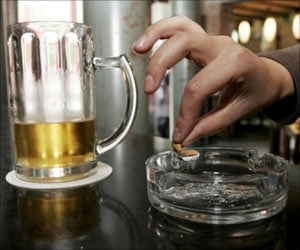The impact on gastric health of environmental pollutants and alcohol intake has been precisely mapped by new research
The impact on gastric health of environmental pollutants and alcohol intake has been precisely mapped by new research.
Both studies being presented this week during Digestive Disease Week® 2009 (DDW®) offer concrete evidence that the environment and alcohol intake can affect GI health and share important insights into new directions for future research. DDW is the largest international gathering of physicians and researchers in the fields of gastroenterology, hepatology, endoscopy and gastrointestinal surgery."Past research has indicated that elements in our environment produce reactions that affect our health," said Marcia R. Cruz-Correa, MD, PhD, FASGE, AGAF, University of Puerto Rico. "The research presented today offers new insights about the influences of a variety of environmental factors, some of which may help explain the high prevalence of certain health conditions."
Non-Specific Abdominal Pain: Could Air Pollution be the Culprit? (Abstract #1055)
Abdominal pain is among the most common reasons for visits to emergency departments and a new study suggests air pollution could play a role, especially among young women. The study builds upon previous research linking air pollution to adverse health effects.
"The study adds to the body of evidence that air pollution exposure negatively affects health," said Dr. Gilaad Kaplan, MD, assistant professor of medicine, University of Calgary. "In addition to lung and cardiovascular disease, this study demonstrates that there is also the potential for air pollution to affect the gastrointestinal tract."
Kaplan and his co-authors set out to study the link between air pollution and non-specific abdominal pain (NSAP). NSAP is diagnosed when the cause of abdominal pain is not discovered and triggers of acute pain are not known. The investigators identified more than 95,000 patients discharged from emergency departments with NSAP from hospitals in Edmonton, Alberta. The study was replicated in more than 25,000 abdominal pain patients presenting to a hospital in downtown Montreal, Quebec. Data from Environment Canada's National Air Pollution Surveillance were used to determine the hourly levels of ozone (O3), nitrogen dioxide (NO2), sulphur dioxide (SO2), carbon monoxide (CO) and particulate matter of varying sizes (PM10 & PM2.5).
Advertisement
Kaplan and his co-authors speculate that young women are the most affected cohort because they are at increased risk for functional motility disorders, the most common of which is irritable bowel syndrome. He adds, however, that this research is in its early stages and that future studies will need to confirm the connection between air pollution and abdominal pain and to learn the mechanism by which air pollution may contribute to the development of abdominal pain.
Advertisement
Alcohol Intake and Development of Symptomatic Gallstones: An Inverse Association — A UK Prospective Cohort Study (Abstract #15)
Scientists have known that alcohol intake has a protective effect against the formation of gallstones, but a new study establishes for the first time the precise quantitative effect of each unit of alcohol on the development of gallstones.
Using questionnaires, investigators measured the dietary habits of 25,639 men and women and followed them for a ten-year period, during which time 267 patients developed gallstones. Participants in the study provided detailed information on the frequency and quantity of their alcohol intake. Researchers found that those who reported consuming two UK units of alcohol per day had a one-third reduction in their risk of developing gallstones. Each unit of alcohol consumed per week reduced the chances of gallstones by 3 percent. One UK unit of alcohol contains eight grams of alcohol; one standard drink in the U.S. is equal to 14 grams of alcohol.
Researchers emphasized that their findings show the benefits of moderate alcohol intake but stress that excessive alcohol intake can cause health problems. Quantifying how much alcohol reduces the risk of gallstone development allows doctors to offer specific guidance without introducing the risk of excessive alcohol consumption.
"These findings are important to developing our understanding of the development of gallstones. Once we examine all the factors related to their development in our study in the UK, including diet, exercise, body weight and alcohol intake, we can develop a precise understanding of what causes gallstones and how to prevent them," said Andrew Hart, MD, senior lecturer in gastroenterology at The Norfolk and Norwich University Hospital and The University of East Anglia, in the United Kingdom.
Dr. Hart and Dr. Paul R. Banim will present these data on Sunday, May 31 at 8:30 a.m. CDT in S502, McCormick Place.
Source-Eurekalert
RAS















